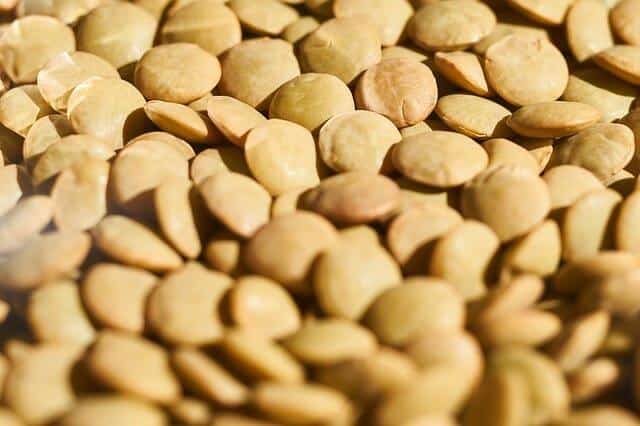If you are looking to add some powerhouse nutrition, be sure to consider lentils.
Lentils are legumes, and when compared with other dried beans, they are easy and quick to prepare since they do not require presoaking. However, they offer high nutritional content, and they readily absorb other flavors in your soups, stews and side dishes. Even better: They will store for years and years.
Lentils originated in central Asia and are one of the world’s first cultivated foods. In fact, lentil seeds dating back to Old Testament times have been discovered at archeological sites in the Middle East. Sometime before the first century, lentils made their way to India, where they became the basis of the popular Indian dish, dal.
There are dozens of varieties of lentils, and they are classified by size and by color. Although green and brown lentils are the most common types in the U.S., lentils also come in orange, red, yellow and black varieties. Flavors differ slightly among the different types, but each one offers a rich, dense, slightly nutty taste.
The ‘Miracle Oil Maker’ Lets You Make Fresh Nut Oils Within Minutes!
Here are some of the many health benefits lentils can provide.
Manganese. Stored in the bones and in the liver, pancreas and kidneys, this mineral helps the body maintain a normal level of blood sugar. It also offers protection against free radicals. A 100-gram serving of red lentils provides 100 percent of your daily manganese requirements.
Protein. If you are a vegetarian or are just looking to increase your protein intake, lentils are a great choice. A half cup serving of dry lentils provides 26 grams of energy-packed protein. They also are naturally gluten-free. Lentils are one of the best sources of alkaline protein, which means they can help balance the body’s pH level, promoting a healthy gut.
Fiber. If you consume 100 grams of dry green lentils, you will get 80 percent of your day’s fiber recommendation. A high daily intake of dietary fiber can help lower your “bad” cholesterol levels and offer protection against developing Type 2 diabetes and colon cancer. High fiber also regulates the digestive system, helping to prevent constipation, diarrhea, inflammatory bowel disease and diverticulitis.
Potassium. Potassium is helpful in regulating blood pressure, and it can help fight the damaging effects of too much sodium in the diet. A 100-gram serving of red lentils offers more potassium content than a large banana.
Folate. Folate plays an important part in heart health, nerve function and the formation of red blood cells. It helps prevent anemia and is very important in helping increase the blood volume of pregnant women and women of childbearing age in general.
Iron. You can take a natural iron supplement by eating 100 grams of lentils, which provides almost half of your daily iron requirement. Iron helps in the formation of hemoglobin in the blood and myoglobin in the muscles, both of which help fight against fatigue and tiredness.
Low starch content. Compared with refined grains and packaged carbohydrates, lentils have a low impact on blood sugar levels. Lentils contain about 35 percent digestible starch, and about 65 percent resistant starch, which is the type that escapes absorption in the small intestines. Eating lentils can help curb your appetite, since they are low in calories yet are satisfying.
How to Purchase Lentils
Lentils are available in prepackaged containers and in bulk bins. Look for lentils that are whole and without cracks and without any evidence of damage from insects or moisture.
Unlike many canned vegetables, canned lentils retain most of their nutrition. Check the label, however, to avoid added salt or other ingredients.
Storage
When dry lentils are stored in an airtight container in a cool, dry and dark place, they will store for years. Cooked lentils will stay fresh in the refrigerator for about three days in a covered container.
Cooking With Lentils
Spread lentils out on a light plate or surface to check for and to remove any small rocks or other debris. Then rinse lentils in a strainer under cool running water.
To boil lentils, use one cup of lentils per three cups of liquid. For lentils that are easier to digest, place them in water that is already boiling. When the water returns to a full boil, turn down heat to a simmer and cover the pot. Red lentils take about 20 minutes to cook, while green lentils take about 30 minutes.
You can lengthen or shorten this time depending on the consistency you desire. For example, you might want to cook them for less time if you want a firmer texture for a salad or soup. If you are making a curry or a dal, however, you may want to increase the cooking time so your lentils have a softer consistency.
Have you ever eaten or stored lentils? What advice would you add? Share your tips in the section below:
Here are some recipes for lentils you may want to consider:
https://allrecipes.com/recipes/16982/fruits-and-vegetables/beans-and-peas/lentils/
https://www.thekitchn.com/20-lentil-recipes-for-easy-weeknight-meals-227286
https://minimalistbaker.com/1-pot-lentil-dal/
https://minimalistbaker.com/1-pot-lentil-dal/
https://www.huffingtonpost.com/2015/03/24/lentil-recipes_n_1070678.html
https://www.cookinglight.com/food/recipe-finder/lentil-recipes
 Off The Grid News Better Ideas For Off The Grid Living
Off The Grid News Better Ideas For Off The Grid Living





